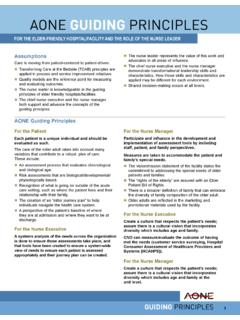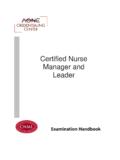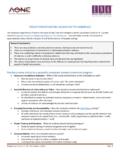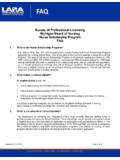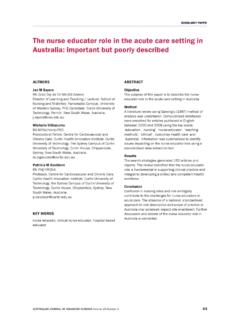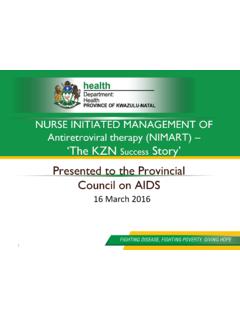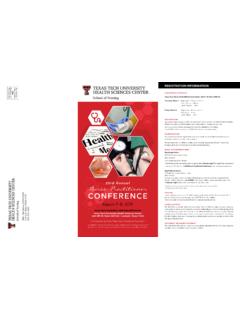Transcription of AONE Guiding Principles for the Chief Nurse Executive ...
1 Introduction Technology is crucial to the health care environment of the future. The integration of technology into health care is occurring at a rapid rate and when leveraged appropriately, will be a major asset for health care reform; especially when used to enhance clinical outcomes. Success will be affected by the presence of collaboration between the clinical information technology (IT) department and the nursing department. This success can be further enhanced by including information technology industry partners in strategic and operational initiatives. This document outlines the basis for establishing a successful relationship between the Chief Nurse Executive (CNE), Chief information officer (CIO) and industry partners.
2 These Principles were developed during a Day of Dialogue that brought together CNEs from the American Organization of Nurse Executives (AONE), CIOs from the College of Healthcare Information Management Executives (CHIME) and industry partners from Hill-Rom. Their task was to develop Guiding Principles that outline how these three stakeholders can work together to achieve enhanced quality outcomes for the patients and families we all serve. Each of the three stakeholders has a perspective on how they perform their work and what they require to most effectively meet their goals. However, they don t always share these perspectives, which could enhance their relationships. One starting point is to clearly articulate their varied perspectives so that there is mutual understanding and appreciation of goals and challenges.
3 By sharing goals and challenges during the Day of Dialogue, the workgroup that drafted these Principles discovered that among the stakeholders individual goals had more in common than was originally realized and the identified challenges were more aligned than expected. When focusing on how to leverage the relationships between nursing, information and clinical technology, and industry partners, four Principles emerged as ways to ultimately enhance clinical outcomes. These Principles include: Establish a culture of collaboration between the CNE, CIO, and industry partners. Build relationships and trust. Create strategic and operational alignment. Establish a culture of collaboration for innovation and transformation.
4 Each of these Principles were expanded to provide a roadmap for how relationships can be developed in hospitals and health systems to leverage clinical and information technology to the greatest degree possible. Guiding Principles Guiding Principle #1 Establish a culture of collaboration between the CNE, CIO and industry partners. Goals Gain senior leadership commitment to work in collaboration to achieve the organization s IT goals. Leadership should lead the way by focusing on the critical goals for success, measuring what is important, and rewarding positive results. Create and articulate the model for communication and governance for IT initiatives within the facility/system.
5 This gives the CNE and CIO clarity for how communication will occur and how decisions will be made fostering transparency and knowledge of the process. It also assists industry partners to participate as an FOR THE Chief Nurse Executive , Chief INFORMATION OFFICER AND INDUSTRY PARTNERS TO WORK TOGETHER TO LEVERAGE TECHNOLOGY TO ENHANCE CLINICAL OUTCOMES effective member of the team. Identify a champion to take resonsibility for ensuring that the needed structures and support for collaboration are in place. Building the infrastructure to support collaboration doesn t happen by chance. Structure can assist the team in staying on track and working together. Establish role clarity and expectations.
6 This provides necessary guidance for individual responsibility and operationalizes the structure to support the collaboration. Individual staff members should know their responsibilities and what they are accountable for achieving. The full team should understand who is responsible for different aspects of the projects to streamline work processes. Create a common vision for the culture to clarify expectations, structure and roles for all involved. Clearly highlight the path for how parties will work to achieve collaboration as a means to leverage IT to enhance clinical outcomes. The partnership of the CNO and CIO should support collaboration within the staff teams and with the industry partners, delineating how to work together.
7 Activities to Achieve These Goals Articulate an IT strategy that establishes metrics for success. Coach/mentor staff to help and develop collaboration skills. Publicly identify, promote and reward behaviors that drive collaboration. Be cognizant of the skills/behaviors that create organizational excellence and collaborative practices. Leverage meaningful use to drive positive organizational change. Guiding Principle #2 Build relationships and trust between the CNE and the CIO. Goals Create opportunities to walk in each other s shoes. Because both roles are complex and demanding, mutual appreciation for the challenges each faces is beneficial for treating mutual understanding of how the CNE and CIO can support each other.
8 Create shared values, camaraderie, traditions and rituals. These are aspects of culture that build strong relationships. For example, attending outside meetings as a CNE/CIO team provides the opportunity to work together in a different way. Create a relationship competency compact a how to for building and maintaining collaboration. This compact provides an intentional agreement for how the CNE and CIO will work together. Role model integrity in every interaction as a foundation for trust and success. The ability and commitment to being truthful with each other is a critical component of demonstrating trust. Plan and execute a trust building program using internal and external resources.
9 Schedule protected time to deliberately work on relationship building and don t assume it will happen without focused intention. Activities to Achieve These Goals Develop templates or tools to help understand each other s role and responsibilities and define what current metrics and priorities are driving each other s work. Converge both clinical and IT scorecards FOR THE Chief Nurse Executive , Chief INFORMATION OFFICER AND INDUSTRY PARTNERS TO WORK TOGETHER TO LEVERAGE TECHNOLOGY TO ENHANCE CLINICAL OUTCOMES and goals to develop organizational targets for alignment. Lead by example in displaying trust and collaboration. Focus on what is working and build on success.
10 Invest the time to develop relationships and trust. Do not assume that trust happens without intentional effort. Guiding Principle #3 Create Strategic and Operational Alignment of IT Solutions. Goals Hold regular evaluations of IT operational plans and adjust tactics as a team. Include key stakeholders in the planning process for IT solutions. This includes staff at all user points especially staff who are the end users of solutions. Start at the beginning of IT planning so the solutions are validated by end users up front and not at the end of planning. Develop an inclusive roadmap for IT strategic planning that includes industry partners. All have a stake in the success of IT implementation, and each brings a different perspective.



